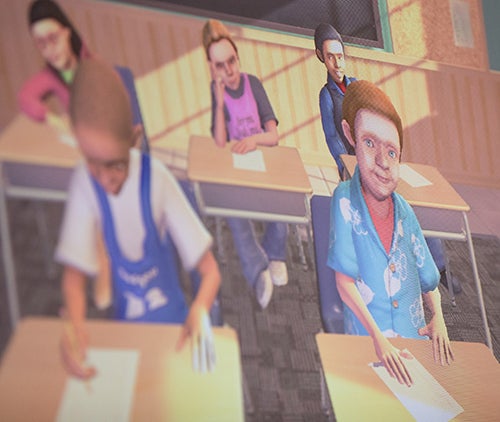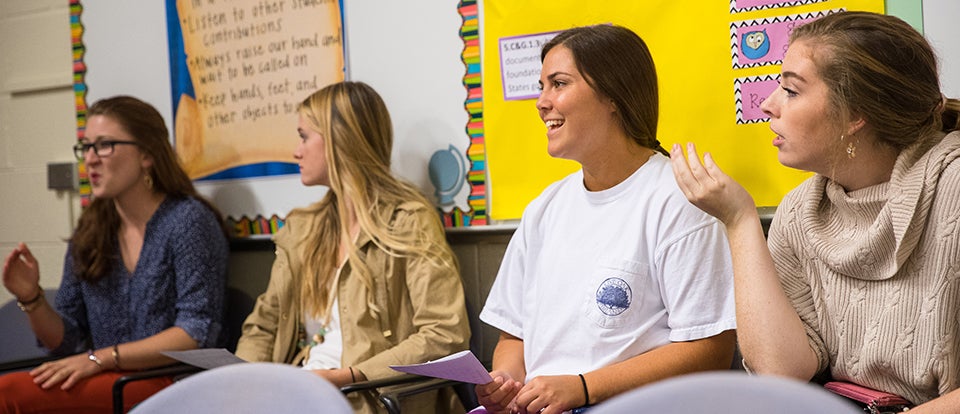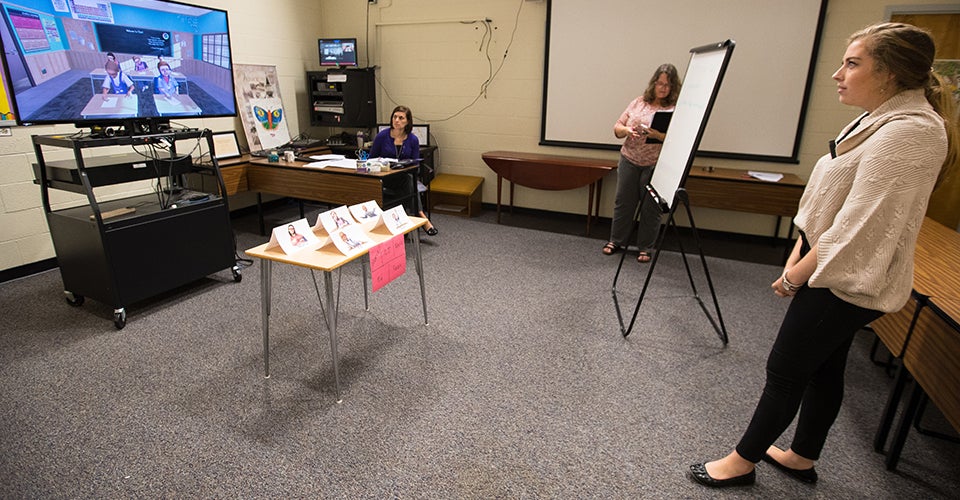ALMOST LIVE
Student teachers learn from virtual classroom
A new tool in East Carolina University’s College of Education is helping students prepare to teach in their own classroom one day.
The virtual reality program, called Mursion, provides possible scenarios in a simulated classroom environment with a range of student personalities, from the first-to-raise-their-hand to the distracted or shy student.
ECU is the first in the UNC system to use the program, said Christine Wilson, instructional technology consultant, webmaster and Blackboard support specialist in the College of Education.
“This mixed-reality teaching environment supports teacher practice in classroom management and content and provides our candidates the opportunity to learn new skills and effective teaching techniques without placing ‘real’ students at risk during the learning process,” said Dr. Grant Hayes, dean of the College of Education. “Students also receive immediate feedback on their performance from both their peers and instructors.”
On a recent afternoon, five students in associate professor Karen Voytecki’s class took turns simulating the first day of school, challenged to keep the virtual students on task and focused while sharing expectations for the school year. Each stood before a large screen projecting the virtual classroom.

ECU junior Courtney Vitale writes expectations for the school year on a white board in collaboration with her virtual students.
Brianna Soares, a junior special education major from Collegeville, Pennsylvania, said the program forced her to think differently about her response to students.
“Unless you’re doing Mursion, you want to walk around the class,” said Soares. “You have to change how you plan your lessons, but student-wise, they’re very similar.”
She noted that each of the virtual students exhibited a behavioral habit, like CJ, who was always on her cell phone, or Sean, who liked to have input on every subject. “It’s learning their quirks just like you have to learn the quirks of students in your classroom,” Soares said.
Callie Anderson, a junior adapted special education major from Raleigh, said responding to some of the students’ negative behaviors while she stood fixed in front of the class was challenging.
“I’m not going to call out a student in front of the class (in a real classroom), I’m going to walk over to them and put my hand on their shoulder (to get their attention),” Anderson said.
Voytecki said the program allows for a teacher to have a one-on-one, private conversation with a student as the camera zooms in, capturing the moment.
“I never thought I’d be able to teach from a video camera,” Soares added.
Each ECU student taught for five minutes, while their peers tallied positive and negative virtual student behaviors. Afterward the student teacher went to another classroom in Speight to talk about their experience, then returned to participate in a group debriefing session with Voytecki.
“I’m super proud of each of you,” Voytecki said, complimenting her students on engaging the classroom, using enthusiastic voices and being able to relate to and re-direct the virtual students, particularly with behavior management. “In the adaptive curriculum, you’ll get a range of students.”
Voytecki said the Mursion teaching experience has been a positive one for her students.

These virtual students interact with ECU student teachers through the Mursion program.
“Mursion gives them the opportunity to teach students, practice classroom management techniques and model instructional strategies in a safe environment where debriefing and reflections occur immediately after,” she said. “Although students wish they had longer time periods to use the Mursion lab (and extended teaching times), they commented on how it has improved their confidence in being able to successfully manage a class of students.”
The program provides “a new sense of realism that just hasn’t been available before outside of an actual classroom,” Wilson said. “We are very fortunate that ECU has had the foresight to bring this technology to campus and our faculty has embraced it.”
The use of the Mursion program has grown from one class this spring to four different program areas this fall, Wilson said. In addition to special education, educational leadership and school administration, elementary education and art education are using the technology.
The college hopes to add more program areas and make the lab available to ECU students to practice skills outside of regularly scheduled classes, she said.
Organizers also are looking at partnering with other schools and colleges on campus to offer Mursion simulations in hospitality management, business and health care, Wilson said.
“In the spring, we plan to begin looking at these possibilities as well as branching out into the schools to offer professional development to practicing teachers,” she said. “Mursion provides a level of practice that just cannot be gained through any other means.”
For more information, visit ecu.edu/Mursion.

Students in associate professor Karen Voytecki’s class in the College of Education talk about their use of the virtual reality program called Mursion.
